Oct 25, 2016 | coins, fun, history, silver

The original bit coin.
In a comment about a technical issue, I was trying to explain that something would not work and exclaimed, “That isn’t worth two-bits.”
To the few people in the room within my age group, they understood what I said. Those younger than being eligible for AARP and those born outside of the United States did not understand. Since it is more blessed to give rather than receive, it gave me the opportunity to teach someone about the origin of money in the United States.
When the colonies were settled, George I was the King of England. Although the king ruled from an ocean away, the governors sent to manage the colonies on his behalf were under strict orders to not allow the colonists to coin money. An exception was made during a small period in the 17th century, colonists had to make due with the low-value copper coinage the king and his governors allowed.
Even with a standing army in the colonies, the governors could not control the commerce. Instead, they applied duties and fees for allowing the colonists to trade with the rest of the Western Hemisphere. Notice that there were no taxes because only the king could tax the royal subjects. Governors could levy duties to run the colonies. They also took kickbacks and bribes in order to get their way.
Although the Pound Sterling was the coin of the realm it was not available to the colonies. Instead, trading posts accepted the 8 reales coin, also known as the Thaler or Spanish Milled Dollar, as payment for goods and services. With the trade of high-cost goods like tobacco, cotton, and hides caught in the Appalachian Mountains the colonies relied more on the Spanish Milled Dollar than on the copper British coins.
Colonial governors ignored the growing economy, as they were able to satisfy the companies that sponsored the settlements and paid the taxes while lining their pockets. Colonists were able to make do with what was left.
A problem came about that everything could not be worth 8 reales and without subsidiary coinage, it was impossible to give change. Using the silver value of the coin, people would cut the coin into pieces in order to make subsidiary coinage. A milled dollar cut in half was a half-dollar. That half-dollar cut in half was a quarter-dollar and the quarter-dollar cut in half was called a bit.
The bit was the basic unit of commerce since prices were based on the bit. Of course, this was not a perfect solution. It was difficult to cut the quarter-dollars in half with great consistency which created problems when the bit was too small, called a short bit. Sometimes, goods or services would be adjusted to accommodate the short bit. Other times, short bits were supplemented with the English pennies that were allowed to circulate in the colonies.
Getting back to our adage, two bits were made from a quarter-dollar. Saying something was not worth two bits was either a negotiating tactic or someone wanted to use a short bit to pay for an item. Like many adages that have origins in the 17th and 18th centuries, the reason for their existence has been lost with time.
But arguing about its origin would be rocking the boat. We do know that some of our colonial ancestors should have measured twice and cut once to avoid the problem. But alas, there is no sense crying over spilled milk.
From my collection
-
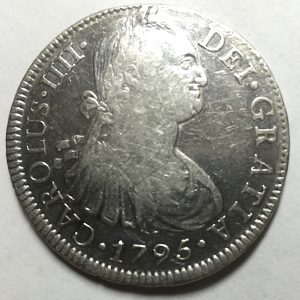
-
Obverse of a 1795 8 Reales silver Thaler
-
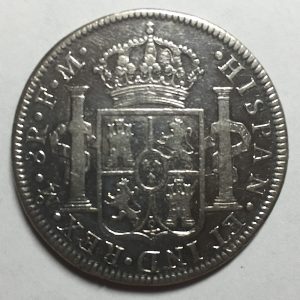
-
Reverse of a 1795 8 Reales Thaler; also know as the Pillar dollar or Spanish Milled dollar
Sep 22, 2016 | copper, history, markets, tokens
Have you noticed that every election “is the most important in our history?” Or that “you have no clearer choice” than whatever any of the candidates are selling? There are so many clichés that it would require its own blog post.
But what does that have to do with numismatics?
Long-Stanton Manufacturing Company was founded in 1862 by John Stanton to make copper tokens that were used by merchants in the Cincinnati area when money was in short supply during the Civil War. Before starting his company, Stanton owned a company that provided the illustrations and dies that were used to make advertising tokens for the 1860 election.
The Election of 1860 preceded the outbreak of the Civil War. It featured fractured party nominees arguing over the future of the union. The Republican Party, formed out of the ashes of the Whig Party, nominated former representative from Illinois Abraham Lincoln. The Democratic Party nominated Illinois Senator Stephen A. Douglas. But the Democrats were split along the issue of slavery. Pro-slavery southern Democrats formed their own party and nominated then Vice President John C. Breckinridge from Kentucky. A few other candidates were nominated but these were the three that were the focus of the election.
One thing that is considered a highlight of this campaign were the famous debates between Abraham Lincoln and Stephen Douglas. The main theme of the seven debates was slavery. Primarily, Lincoln was anti-slavery and maintaining the union. Douglas was not pro-slavery but favored new territories to choose their own paths. Lincoln argued in his “House Divided” speech that Douglas wanted to nationalize slavery. This came following Douglas’s sponsoring of the Kansas-Nebraska Act that repealed the ban on slavery in the new territories passed as part of the Missouri Compromise.
Although the use of language was more refined in 1858, the issues were just as divisive.
Seven debates were not enough for the public. Manufacturers, such as the one that Stanton provided illustration and die making services for, struck tokens for the candidates and their supporters to give away to gain support. Lincoln won the Election of 1860 with a majority of the electoral votes carrying 18 of 33 states while gaining only 39.8-percent of the popular vote.
Some say the election of 2016 is the most divided in our history. If we do not count the Election of 1824 in which nobody received a majority of electoral votes and the results had to be decided by the House of Representatives, it could be one of the more contentious election since the 1976 Carter-Ford race.
The folks at Long-Stanton thinks there is an indecision in this election, although the polls show that the country is about evenly split. They think to celebrate the 156 years since John Stanton created his tokens the company created their Indecision 2016 token.
Indecision 2016 token is 39mm and made of brass. Portraits of each of the candidates are on either side. If you are undecided, you can flip the token to choose who you will vote for.
Unfortunately, the portraits barely represent the candidates. While the TRUMP side of the token is passible the CLINTON side would not be recognizable if it was not marked. While I do not consider either candidate physically attractive these portraits are worse.
Since it is expensive to produce tokens and medals to just give away, the tradition of striking these types of pocket pieces are no longer part of the campaign. If you have ever read Warman’s Political Collectibles: Identification and Price Guide, you would see all the interesting trinkets that would be produced in support of the candidates. Nowadays, those who collect political memorabilia would be hard pressed to find something more than a button or lapel pin.
Having received the Brexit token, I decided to purchase one of the Long-Stanton Indecision 2016 tokens for my collection. Although the token looks better in hand since it has a proof-like strike, a close-up view of the portraits are about as bad as the images on Long-Stanton’s website. For $8.95 for a single token, including shipping, it is not a bad deal. They do offer discounts for buying more than a few.
-
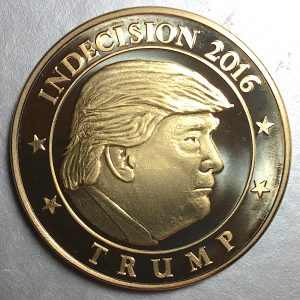
-
Long-Stanton Indecision 2016 Token – Donald Trump side
-
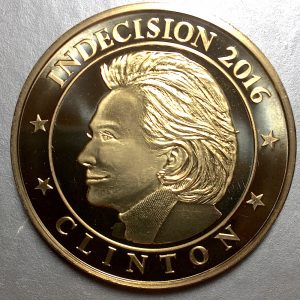
-
Long-Stanton Indecision 2016 Token – Hillary Clinton side
Included in the package was an aluminum token from Long-Stanton that is “GOOD FOR 50 IN MERCHANDISE.” It does not identify the exact value of 50 whether it means cents or dollars, but it does not matter since it is unlikely to be redeemed from my collection. At 31mm it is smaller than the Indecision 2016 token but it is a throwback to times when tokens were created for store credit before paper coupons became ubiquitous.
-

-
Aluminum Long-Stanton Manufacturing Token
-
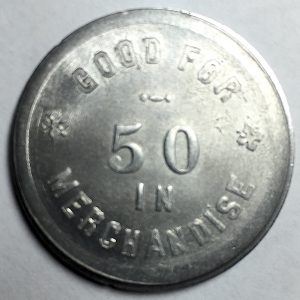
-
Aluminum Long-Stanton Manufacturing Token reverse offering “50 IN MERCHANDISE”
Rather than go with my numismatic collection, this token will go along with a small collection I have of political memorabilia. It will join other numismatic-related items that are related to my favorite president Teddy Roosevelt. I hope he is not insulted by either of these candidates. Somehow, I think T.R., George Washington, Thomas Jefferson and Abraham Lincoln might not be happy if they were around today.
Aug 6, 2016 | economy, history, tokens
For as long as there has been money or commerce, there has been some form of credit. Whether it was borrowing a few coins until the next payday or today’s credit cards, credit has been a fuel of economic development for quite some time. The financial industry is built on credit and charging customers to borrow money and spread the payments out over time. By some estimates the average household owes over $16,000 in credit card debt.
The United States was founded on credit. During the founding of the country currency had been limited to coins with an intrinsic value based on their gold, silver or copper content. As the King of England tried to tax the colonies to pay for the wars in Europe, the colonies looked for ways of financing their own governments to provide services. they issued paper notes. These notes functioned as currency but actually were bills of credit, short-term public loans to the government. For the first time, the money had no intrinsic value but was valued at the rate issued by the government of the colony in payment of debt. Every time the colonial government would need money, they would authorize the printing of a specified quantity and denomination of notes that it would use to pay creditors. The emission laws also included a tax that would used to repay the bill of credit and the promised interest.
Later, the era we now refer to as Obsolete Banknotes (or Broken Banknotes), were currency issued by banks under permission of the Department of the Treasury that were supposed to be backed by the assets of the issuing bank. Banks were supposed to be able to back at least 90-percent of the value of the notes with hard currency. But the banks were not honest with the Treasury Department, issued more currency than assets, and many went out of business because they could not cover the value of the notes issued.
Credit run amok has been the cause of nearly every major market downturn in history including the most recent dire recession that began in 2008.
The concept of institutionalizing consumer debt was first written about in Looking Backward, 2000 to 1887 by Edward Bellamy. Bellamy, a writer from Massachusetts, wrote about Julian West, a young American who falls into a deep, hypnotic sleep and wakes up in the year 2000. As part of West’s experience, Bellamy describes purchases being made using a credit card. Bellamy’s credit card was limited to the amount on deposit. The description is more like a debit or secured credit card of today. After the book became popular, the concept of consumer credit began to be institutionalized.
Hotels and other higher-end retailers were first. They would create medals or tokens that could be carried in the pocket or have a hole to include them on a keychain. Much like the Colgate tokens previously written about, the use of metal tags and tokens began at the beginning of the 20th century and was stopped by the War War II efforts.
Credit tokens were nondescript items with the name of the establishment and the user’s account number which lead to a number of problems. Since the account number was engraved into the tag, it was up to the cashier to write down the account number. Mistakes would lead to unpaid bills. A later improvement was to include raised letters that could be rubbed onto the paper using a pencil or carbon paper in order to record the number correctly, a feature that would be added to the plastic charge plate before the invention of the magnetic strip.
These tokens did not include the customer’s name. Although many can be mailed to the company so that the keys could be returned to the original owner, thieves would keep the tokens and use them. Stores would later have to produce lists of invalid or stolen charge numbers to verify the sale at the register. In the day before computers, this was a time consuming task.
Stores continue to think the risks are worth dealing with since credit purchases appear to be more popular than cash-based purchases.
One of the early adopters of credit purchases was Abraham & Straus, Inc. Founded in 1865 by Abraham Abraham in Brooklyn, the store was operated on Fulton Street as a small clothing outlet until its later flagship store was built closer to downtown Brooklyn in 1883. As part of expanding the store and funding the move, Abraham received funding from Nathan and Isidore Straus. When the company reopened at 422 Fulton Street the was renamed Abraham & Straus, the name that was used until its closing in 1995.
-

-
A&S Charge Token with account number
-
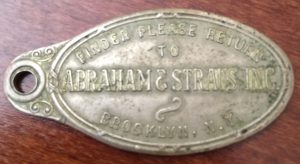
-
If found return it to A&S in Brooklyn!
Known as A&S throughout the New York metropolitan area, it was a little more upscale from other discount stores of the time. Although the stores expanded as far as the Philadelphia region, it would not see the same success as the New York-area stores. A&S was a favorite amongst the burgeoning middle class of the post-World War II Baby Boomer generation especially for women’s clothes. I have a lot of memories waiting outside of the A&S with my father at the Green Acres Mall in Valley Stream, NY as my (late) mother would go shopping in A&S. And the family car, a black 1963 Chevy Impala with red interior, did not include air conditioning!
Apparently, I survived those shopping trips along with my recent find an on old A&S credit token. While searching through a cigar box of old tokens, I found this pre-World War II item. Aside from bringing back the memories, and reminder of the hot days waiting for my mother to try on nearly every dress in the store, I though this would be a perfect addition to my collection of New York numismatic memorabilia.
Remember, you do not have to collect coins to have fun with numismatics!
NOTE: Electronic versions of
Looking Backward, 2000 to 1887 by Edward Bellamy can be downloaded from
Project Gutenberg.
Aug 3, 2016 | history, tokens
Proof that numismatics can be used to learn more about history through the economics they represent. Sometimes more telling than coins are exonumia items which have more descriptive value than coins.
Rummaging through a bag of small items recently purchased from an estate sale I found two square tokens. Both are made of aluminum and measured 27mm per side (about 1-inch). Both offer 10-cents off a purchase of personal care products. One will provide a discount on Colgate’s or Palmolive Shave Cream and the other for 10-cents off for the purchase of Colgate’s Ribbon Dental Cream.
-

-
Good for 10c on your next purchase of Colgate’s or Palmolive Shave Cream
-

-
Reverse of 10c token for Colgate’s or Palmolive shaving cream
While these tokens are very interesting, I want to know when they are from? After examining both sides of each token and not finding any indication of a date, it was time to turn to an Internet search engine to figure out when this token could have been made. We start with looking for the company and product information for Colgate-Palmolive-Peet. From this, we found the history of today’s Colgate-Palmolive.
-
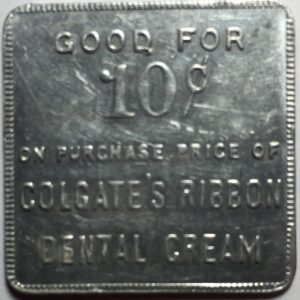
-
Good for 10c on purchase price of Colgate’s Ribbon Dental Cream
-
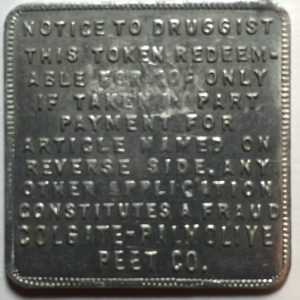
-
Reverse of 10c off purchase of Colgate’s Ribbon Dental Cream token
The company was founded in 1806 by English immigrant soap and candle maker William Colgate. Colgate began by making candles, soap and starch in a factory on Dutch Street in New York City under the name William Colgate & Company. Colgate was the first company to begin selling individual soap cakes in uniform sizes. Following William Colgate’s death in 1857, his son Samuel Colgate reorganized business as Colgate & Company. Samuel did not want to run his father’s business but felt its continued existence with the right thing to do.
NOTICE TO DRUGGIST
THIS TOKEN REDEEM-
ABLE FOR 10¢ ONLY
IF TAKEN IN PART
PAYMENT FOR
ARTICLE NAMED ON
REVERSE SIDE. ANY
OTHER APPLICATION
CONSTITUTES A FRAUD
COLGATE-PALMOLIVE
PEET CO.
Text on tokens
Colgate & Company continued to grow. By 1866 the company introduced the first perfumed soap which was then followed by Cashmere Bouquet. It was the first milled perfumed toilet soap, became a registered trademark in 1872. The next year Colgate introduced their first toothpaste that were sold in jars. The product did not sell well until 1896 when Colgate began selling Colgate Ribbon Dental Cream in collapsable tubes. By 1908 Colgate ended production of their jarred toothpaste.
In 1898, B.J. Johnson developed a formula for soap made of palm and olive oils. The soap was so popular that the company was renamed “Palmolive” to reflect the name of its most popular product (I bet you didn’t know where the name came from). By the turn of the century, Palmolive was the world’s best selling soap.
During this time, the Peet Brothers in Missouri was looking to expand their soap business when the opportunity for them to buy Palmolive from B.J. Johnson. In 1926, the merger of the two companies became Palmolive-Peet Company. Two years later in 1928 the Palmolive-Peet merged with Colgate to form Colgate-Palmolive-Peet. Peet was dropped from the name in 1953 to Colgate-Palmolive Company as it is still known as today.
Let’s start with the obvious. Since Colgate-Palmolive-Peet only existed from 1928 through 1953, it would be logical to assume that the token is from that time period.
To try to narrow down the time-period further, I searched for similar tokens to see if I could find other evidence. While searching, I found a set of similar tokens issued by the Palmolive-Peet Company. This suggests that the company could have continued issuing similar tokens following the 1928 merger.
Trade and tax tokens were popular in the use of trade in the 1920s through the depression. In fact, during the depression, many of these tokens were traded as currency in areas where currency was in short supply. However, many of these tokens stopped being used and circulated in 1942. Since aluminum was part of the scrap metal drives that were used to gather the materials to build war equipment, many of these tokens were turned in to merchants who returned them to the companies for cash. Many were later scrapped.
Without having further information the best I can do is narrow the period it was issued from 1928 through 1941.
As part of my search, I found a few listings on eBay that claimed that these tokens were issued in the 1920s. As we have seen that may not be correct. While being issued in 1929 may be possible, it is more likely that these tokens were issued in the early 1930s.
Of course if you have more information about these tokens please leave comments below.
Jul 20, 2016 | celebration, coins, history, medals
 It was July 20, 1969, Neil Armstrong and Edwin “ Buzz” Aldrin, made history by being the first humans to land on Earth’s only natural satellite. A mere 238,900 mile trip began with the launch of the Saturn V rocket from the Kennedy Space Center on July 16, 1969, with Michael Collins who orbited over the moon in the command module, the trip fulfilled the promise of President John F. Kennedy who said to congress on May 25, 1961, “I believe that this nation should commit itself to achieving the goal, before this decade is out, of landing a man on the moon and returning him safely to the earth.”
It was July 20, 1969, Neil Armstrong and Edwin “ Buzz” Aldrin, made history by being the first humans to land on Earth’s only natural satellite. A mere 238,900 mile trip began with the launch of the Saturn V rocket from the Kennedy Space Center on July 16, 1969, with Michael Collins who orbited over the moon in the command module, the trip fulfilled the promise of President John F. Kennedy who said to congress on May 25, 1961, “I believe that this nation should commit itself to achieving the goal, before this decade is out, of landing a man on the moon and returning him safely to the earth.”
Kennedy would have been pleased with the events of 47 years ago, today.
Michael Collins design the mission insignia. Collins said that he wanted a symbol to represent a “peaceful lunar landing by the United States.” He also left the names of the astronauts off of the insignia so that it would represent everyone who worked on the mission. It is one of the few mission insignias that does not include the name of the astronauts.
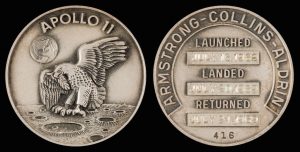
Apollo 11 flown silver Robbins Medal once owned by Wally Schirra
This medal was sold for $33,460.00 on April 18, 2013 by Heritage Auctions.
In March, before the Apollo 11 launch, President Dwight Eisenhower died of congestive heart failure at the age of 78. To honor the late president, congress passed the bill to produce what ended up to be the last large dollar coin with the portrait of Eisenhower. It was Rep. Bob Casey (D-TX) who remembered that Eisenhower created NASA and proposed that the reverse of the coin use the Apollo 11 mission insignia rather than just a heraldic eagle.
The Eisenhower dollar was released in 1971 and struck until 1978. Other than relief and varieties, the only design change was made in honor of the nation’s bicentennial in 1975-76.
-
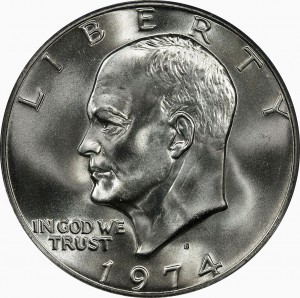
-
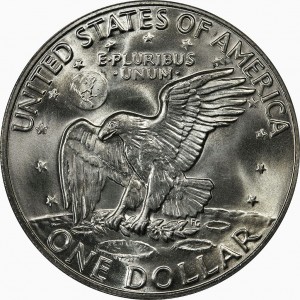
-
Eisenhower Dollar Reverse featuring the Apollo 11 mission insignia
Beginning in 1976, the U.S. Mint was looking to reduce the costs of coin production and was testing different shapes and compositions for a new dollar coin. In order to appease the powerful vending machine industry, the result was a coin that was too similar in size and composition to the quarter dollar. Congress made the decision to honor Susan B. Anthony and leave the Apollo 11 mission insignia on the reverse.
-
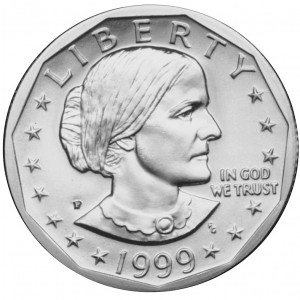
-
Susan B. Anthony dollar
-
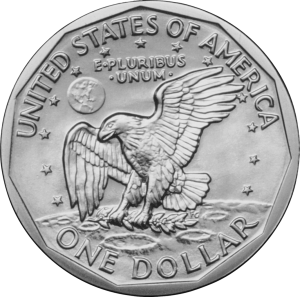
-
Reverse of the Susan B. Anthony dollar featuring the Apollo 11 mission insignia
Chief Engraver Frank Gasparro designed the reverse for both the Eisenhower and SBA dollars using the Apollo 11 mission insignia. An iconic design even though the coins were less than successful.
Credits
- Apollo mission insignia courtesy of NASA.
- Apollo 11 flown Robbins Medal courtesy of Heritage Auctions
- Coin images courtesy of the U.S. Mint.
Jul 16, 2016 | copper, foreign, history, medals, tokens
A few weeks ago I wrote about the potential effects of Brexit on markets should the Brits vote to leave the European Union. When the OUT vote won by a slim margin, there was an instant worldwide reaction. In the subsequent weeks, we have seen world markets react to everything. After an initial fall in markets because of Brexit they have recovered only to be sent back into uncertainty with world events.
The London PM Gold Fix was $1,265.12 before the polls closed on June 23. The next day, the London PM Gold Fix closed at $1,315.50 (4-percent increase). On July 15, the PM Gold Fix closed at $1,327.00, 4.9-percent increase since the vote. Experts are saying gold could continue to climb at the 4-percent rate for the near future.
Silver has been on a slow and steady rise for most of the spring also saw a bump following the Brexit vote. When the London Silver Fix closed at $17.29 on June 23, this was already a $3.29 increase (23.5-percent) from the January 4 first close of 2016 price of $14.00. After the results were announced, London Silver Fix closed at $18.04, a 4.3-percent increase. With the London Silver Fix closing at $20.14 on July 15 (16.48-percent increase), some pundits are suggesting that silver will continue to outperform gold for the near future.
-
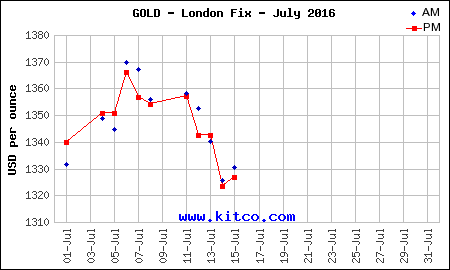
-
Kitco Gold Chart as of 8/15/16
-

-
Kitco Silver Chart as of 8/15/16
When I wrote about Brexit, I also mentioned the “In/Out UK EU Referendum Medallion” produced by Chard(1964), a British metals dealer. After the post, the folks at Chard saw a small bump in sales from collectors the United States from a few of my readers. I was not paid to mention the medal. I just found the information online and thought it was an interesting idea. Shortly before the vote, someone at Chard contacted me and offered to send me some medals.
After a swim across the pond, the medals arrived in my physical mail last weekend. Even though I thought Brexit was a bad idea, the medals are still very cool. Design is the same on both medals. One is copper and the other is Abyssinian Gold, a type of brass made of 90-percent copper and 10-percent zinc that has a gold-like color. Medals are 31mm in diameter and weighs 14 grams making it a nice sized coin for flipping.
-

-
Chard Brexit copper token—IN side
-
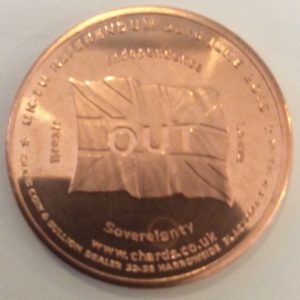
-
Chard Brexit copper token—OUT side
-
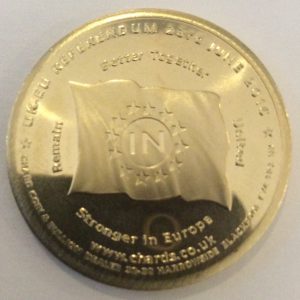
-
Chard Brexit Abyssinian Gold token—IN side
-
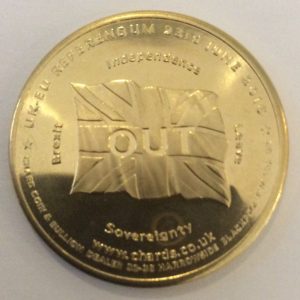
-
Chard Brexit Abyssinian Gold token—OUT side
Chard sent two sets of the medals. I will keep one set and donate the other to my coin club’s annual auction whose proceeds will benefit the Scouts and other numismatic-related education in our region.
It appears that these medals can still be purchased for £2.95 each ($4.33 at the current exchange rate) plus shipping (estimated at £6.00 or $8.80) directly from Chard’s website. I am not making money from this endorsement. I just think it’s a fun collectible!
Static charts courtesy of
Kitco.
Jul 4, 2016 | celebration, history
After nearly a year of war and attempted negotiation with King George III and the British parliament, it became clear that the colonies in the New World would continue to be under harsh rule without representation. In January 1776, the Continental Congress met to discuss the matter.
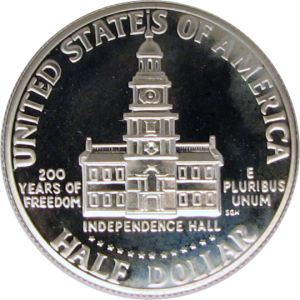 Public support for independence from the British Empire was growing amongst the colonies. Only the “middle colonies” of New York, New Jersey, Delaware, and Maryland who were benefiting financially being part of the British Empire were against independence. When these colonies sent delegations to the Continental Congress, each of their conventions did not allow them to vote for independence.
Public support for independence from the British Empire was growing amongst the colonies. Only the “middle colonies” of New York, New Jersey, Delaware, and Maryland who were benefiting financially being part of the British Empire were against independence. When these colonies sent delegations to the Continental Congress, each of their conventions did not allow them to vote for independence.
As the war with Great Britain dragged on and the attempt at tightening their reigns on the colonies persisted, the populous cry for independence grew. Delegates were set back to their governments and representatives sent to the middle colonies to convince them that the colonies had to declare independence for their own survival. As colonies began to line up with the independence movement, Pennsylvania, New York, Maryland, and South Carolina remained reticent on the subject.
Of the four hold outs, Pennsylvania and Maryland had governments with strong ties to the colonial governors who still had influence. John Adams wrote a draft preamble to explain the independence resolution. Part of the way the resolution was written was, in effect, to overthrow the colonial governments of Pennsylvania and Maryland so that it would be replaced by a popular government. On May 15, 1776, that preamble was passed. The colonies had taken their first step toward independence.
Delegates left the congress and returned to their own colonial conventions. Maryland, whose delegates walked out of the congress in protest, continued to reject the notion of independence. Samuel Chase returned to Maryland and convinced them to allow their delegates to approve the motion of independence. Pennsylvania, New York, and South Carolina remained against the declaration while the Delaware delegates were split.
On June 11, 1776, the “Committee of Five” was appointed to draft a declaration. Committee members were John Adams of Massachusetts, Benjamin Franklin of Pennsylvania, Thomas Jefferson of Virginia, Robert R. Livingston of New York, and Roger Sherman of Connecticut. Although no minutes were kept from the committee meetings, it was accepted that the resulting document was largely Jefferson’s work. The Committee of Five completed the draft on June 28, 1776.
-

-
Robert R. Livingston
-
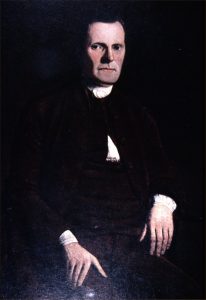
-
Roger Sherman
Debate on the draft declaration began on July 1. After a long day of speeches a vote was taken. Maryland voted yes but Pennsylvania and South Carolina voted no. The New York delegation abstained with out authority from their government to vote. Delaware could not vote because its delegate was split on the question. Edward Rutledge of South Carolina moved to postpone the vote until the next day.
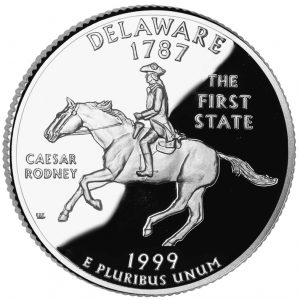 Although there is no written history on what happened that evening, there had to have been lobbying by supporters of independence because on July 2, South Carolina voted yes followed by a turnaround by the Pennsylvania delegation that also voted yes. New York with no authority from their government continued to abstain. With the Delaware delegation deadlocked, this set up the historical ride of Caesar Rodney. Rodney was one of Delaware’s representative to the Continental Congress. He was in Dover attending to other business when he learned that Thomas McKean and George Read were deadlocked on the vote of independence. Rodney rode 80 miles from Dover to Philadelphia to vote with McKean to allow Delaware join eleven other colonies voting in favor of independence.
Although there is no written history on what happened that evening, there had to have been lobbying by supporters of independence because on July 2, South Carolina voted yes followed by a turnaround by the Pennsylvania delegation that also voted yes. New York with no authority from their government continued to abstain. With the Delaware delegation deadlocked, this set up the historical ride of Caesar Rodney. Rodney was one of Delaware’s representative to the Continental Congress. He was in Dover attending to other business when he learned that Thomas McKean and George Read were deadlocked on the vote of independence. Rodney rode 80 miles from Dover to Philadelphia to vote with McKean to allow Delaware join eleven other colonies voting in favor of independence.
With 12 votes for independence and one abstention, the Continental Congress approved the declaration. Jefferson then set forth to make the agreed upon corrections to the document. On July 4, 1776, the Continental Congress approved the wording of the Declaration of Independence. The document was sent to the printer for publication and distribution to the public.
Although historians debate exactly when the final document was signed, it is accepted that the final signatures were added on August 2, 1776. Since New York approved the resolution of independence on July 10, the New York delegation is included amongst the signatures.
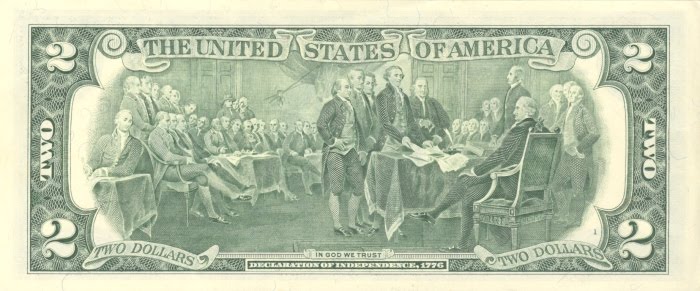

As we celebrate the 240th Birthday of the United States of America, please take a moment to remember those who fought for our freedom and continue to do so today. Honoring them is the best way to honor those whose vision created this great nation.
Credits
- “Declaration of Independence” by John Trumbull hangs in the U.S. Capitol Rotunda and was used as the model for the reverse of the $2 Federal Reserve Note. Image courtesy of Wikipedia.
- Bicentennial half-dollar reverse and Franklin half-dollar images courtesy of the author.
- All other coin images courtesy of the U.S. Mint
- All other images courtesy of Wikipedia.
Jun 17, 2016 | CCAC, CFA, coin design, coins, history, national park quarters
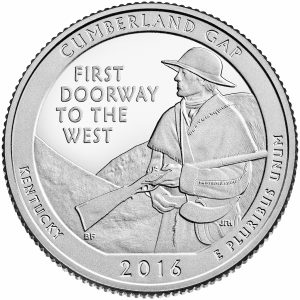
Revere of the 2016 Cumberland Gap Quarter
The artistic error was found by a member of my local coin club who also participates in re-enactments from the Revolutionary War era. Since he is acquainted with the how items from that period look, he told fellow club members about his find.
While looking at the quarter celebrating the Cumberland Gap National Historical Park in Kentucky he noticed something was wrong. A careful examination of the gun shows the flintlock is mounted on the wrong side.
During that time, since most people were right-handed or learned to shoot with their right hand on the trigger, the flintlocks were placed on the right side of the stock. Doing so allowed the flash created by striking the flint to be guided away from the shooter. If the flintlock was placed on the left, the flash would fire into the shooter causing injury.
Manufacturing technology was very different prior to the industrial revolution. Parts were either case manually with molds or formed one at a time where speed was important, especially to satisfy a government’s order to arm soldiers. It would be impractical to alter the basic mechanism for the majority of guns made. Left-handed guns were custom projects that only the wealthy could afford. A frontiersman would not be the type with the means to purchase a custom made gun with a left-handed flintlock.
-

-
Closeup on the backwards flintlock on the Cumberland Gap Quarter
-
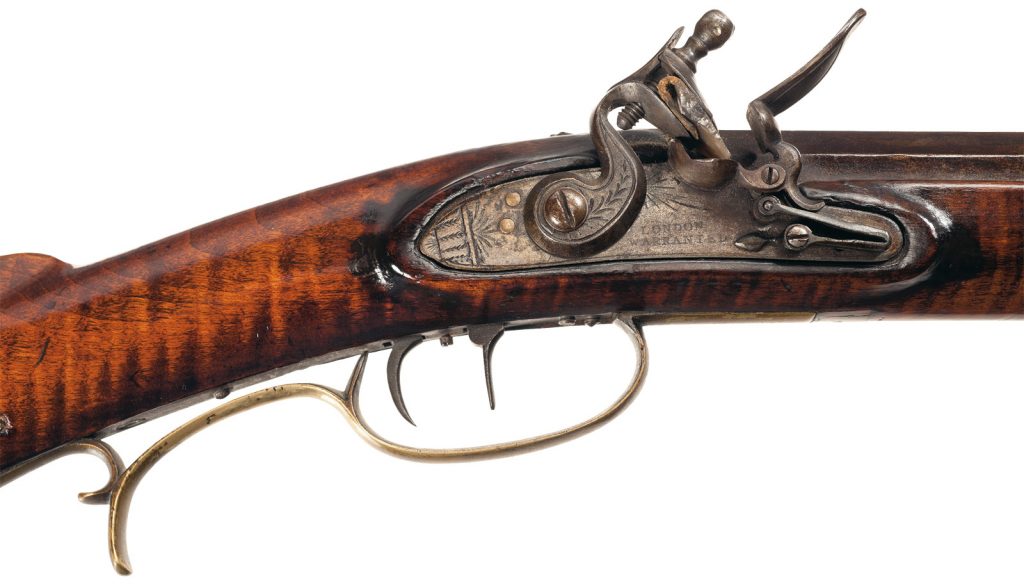
-
Closeup on the flintlock of an M. Martin Flintlock Kentucky Rifle
Further, look how the frontiersman is holding the gun. He is not cradling the gun with the trigger nearby so that he can fire if necessary. The butt, or stock of the gun is extended forward and the barrel pointed backward. Someone suggested that the perspective on the flat coin may make this look different but think about it, how would you hold the gun if you were standing on a ridge looking westward over an untamed landscape?
Although I did not have the eye or knowledge to pick up on this mistake, surely one of the specialists on the CCAC especially the one appointed to the commission who is a specialist in American history. I do not expect much out of the CFA since their specialties are not really fine arts since the majority of their work deals with the aesthetics of buildings, facades, and fencing around the District of Columbia.
There are 11 members of the CCAC and seven in the CFA and not one of them noticed any problems with this image? If they are allowing historically inaccurate images on United States coinage, then what is their purpose?
Feb 12, 2016 | coins, education, history, Royal Mint
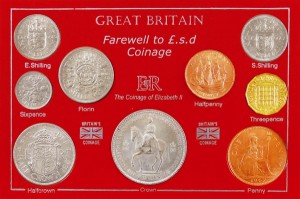
Collection of old pre-decimal coins from during the reign of Queen Elizabeth II.
A very short, simplistic, and incomplete history begins with the Norman conquest of England by William the Conqueror. His invasion of England from Normandy on the northern shores of what is France today in September of 1066 and coronation on December 25, 1066, marks the birth of what would become England.
During the next nearly 50 years, William I (1066-87), William II (1087-1100), and Henry I (1100-35), most of the emphasis has been to finish the conquest and consolidate the ruling under the single crown. The Treaty of Alton (1102) and the subsequent conquest of Normandy (1106) was capable of consolidating power and allowed Henry to attempt to create a sustainable government. Insurgencies from Whales, Rebellion of 1115-20 and the crisis of succession, where is his wife Matilda had not conceived a child, did not allow Henry to finish his work by his death in 1135.
£sd Symbolism
The pound symbol is a fancied “L” based on the Latin librae for weight or balance. It was intended that the 240 pence could be placed on a balance to weigh one pound sterling. The shilling, adapted from the Latin solidus, for solid, was the primary coin of commerce represented with an “s.” For the pence, it used the “d” from the Latin denarius, the smallest Roman coin. Multiple denominations are separated with a slash. For example, 1 shilling can be written as “1/-” while 2 shilling and 3 pence might be written as “2/3d.”
Henry I was succeeded by Stephen, the grandson of William I, with much contention. The problem was that Stephen’s younger brother, Henry of Blois, was embraced by Henry I and subsequently by the Normans. The subsequent civil war lead to a period called “The Anarchy” (1135-1154). During that time Stephen tried to continue with Henry’s reforms but was not able to hold on to the control of the government. Toward the end of his reign, Stephen recognized Henry as the heir to the throne.
With a peace treaty negotiated by Stephen, there was a new peace during the coronation of Henry II in 1154. During the peace, Henry II continued to consolidate power of Norman and Anjou (today this is northern France) and reconstructed the English government.
As part of his reconstruction, Henry II decided to base the currency on the troy pound. The troy pound was based on the Roman libra, which was the basis of weight that England accustomed with. In order to make the money more acceptable, it was divided into 20 units which were originally called testoons. Later, it was renamed as the shilling. As an attempt to make the testoon (shilling) the major unit of currency which corresponded to the Roman solidus. As the solidus was divided into 12 denarii, the testoon was divided further into 12 units with one called a penny and multiples called pence. This was to keep current with the current standard that a pound sterling weight 240 pennyweights.
Early on, it was clear that pence was not small enough of a denomination and was further divided into four parts, two halfpennies or four farthings (quarter pennies). This division was used because the one pennyweight coin representing a penny could not be cut further to represent smaller denominations. Farthings were further divided into smaller denominations using tokes until coins were first used in the 17th century.
To understand this system, I came up with the following table.
| Denomination |
Years struck |
Equivalents |
Relative to a Pound |
Nicknames |
| Quarter farthing |
1839-1853, 1868 |
1/16 d (16 = 1 penny) |
1/3840 pound |
|
| Third farthing |
1827-1913 |
1/12 d (12 = 1 penny) |
1/2880 pound |
|
| Half farthing a |
1828-1856 |
1/8 d (8 = 1 penny) |
1/1920 pound |
|
| Farthing |
1860-1956 |
1/4 d (4 = 1 penny) |
1/960 pound |
|
| Halfpenny |
1672-1860 |
1/2 d (2 = 1 penny) |
1/480 pound |
ha’penny |
| Penny |
1707-1970 |
1d |
240 pence = 1 pound |
|
| Three halfpence |
1834-43, 1860-62 |
11/2 d |
1/160 pound |
|
| Twopence |
1797 |
2d |
1/120 pound |
|
| Threepence b |
1547-1970 |
3d |
1/80 pound |
|
| Groat |
1836-1855, 1888 |
4d |
1/60 pound |
joey, sixpenny bit |
| Sixpence |
1551-1970 |
6d |
1/40 pound |
tanner |
| Shilling |
1503-1970 |
1/- (12 pence) |
1/20 pound |
bob |
| Florin |
1849-1970 |
2/- (24 pence) |
1/10 pound |
two bob bit |
| Half crown |
1707-1970 |
2/6p (26 pence) |
1/8 pound |
|
| Double florin |
1887-1890 |
4/- (52 pence) |
1/5 pound |
|
| Crown |
1707-1965 |
5/- (60 pence) |
1/4 pound |
|
| Sovereign (pound) c |
1817-1917, 1925, 1957- |
240 pence |
10 Shillings |
|
| Half guinea |
1699-1816 |
10/6d |
1/8 ounce of gold |
|
| Guinea d |
1663-1814 |
21/- |
1/4 ounce of gold |
|
Notes:
- Half farthing was originally made for Ceylon
- Three halfpence produced for circulation in the British colonies, mainly in Ceylon and the West Indies
- A one pound coin made of gold was called a Sovereign
- The guinea came into English after the Guinea region of West Africa was discovered by the British and mined its gold
- Not listed is “quid,” the nickname of a one-pound paper note
This was the system until Decimalization Day on February 15, 1971.
Today, British coins are divided into 100 pence to one pound. The coins struck for circulation by the Royal Mint are 1 Penny, 2 Pence, 5 Pence, 10 Pence, 20 Pence, 50 Pence or Half-Pound, £1 (pound), and £2. Paper currency is issued for denominations of £5 and greater.

United Kingdom modern decimalization redesign of 2014 resembles a shield.
Credits
- Image of pre-decimalization coins courtesy of Coincraft
- Image of 2014 United Kingdom shield set courtesy of the Royal Mint
Jan 28, 2016 | celebration, coins, dollar, education, history, US Mint
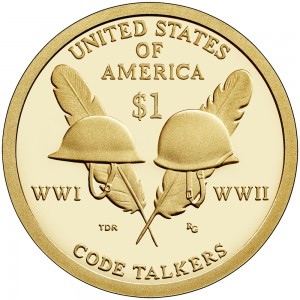
2016 Native American Dollar celebrates the contributions of the Native American Code Talkers in World War I and World War II
The reverse designs has represented some of the best work by the artists working with the U.S. Mint with the 2016 design continuing the record. Celebrating the Native American Code Talkers who were instrumental in using their native language to communicate troop movements and enemy positions, the reverse of the coin celebrates their work.
As someone who has made a career in technology and information security, the concept of using something as low-tech as a language that nobody else can translate to openly communicate secret information is an elegant solution. It proves that technology is an answer but not the only answer. It makes these people heroes for their service to a country that has not treated their people fairly over the course of history.
Learning and honoring the history of Native Americans was the goal of the Native American $1 Coin Act. It is a simple yet effective way to bring history to the masses. Although the dollar coin does not circulate well, it is still a nice way for the country to teach and honor history.
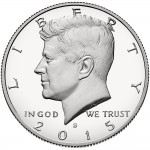
I don’t think JFK would mind using the reverse to honor U.S. history!
As I consider writing a draft version of the bill to send to my representatives in congress, I know that any good coinage program in the United States should have some guidelines. Far be it for congress to tell the U.S. Mint to do what it thinks is right. In order to satisfy something that congress would adopt and create a meaningful program, how about a Half-Dollar history program as follows:
- The obverse will remain unchanged, the edge will continue to be reeded, and the coin will remain a half-dollar
- Reverse design changes annually and only one design per year
- Half-dollar can be made for circulation and the U.S. Mint can create collector versions including silver collectibles and different finishes
- Theme for the reverse must be from 50 years prior to the year of circulation and older with anniversary dates being divisible by 25 (i.e., 50 years ago, 75, 100, 125, 150, etc.)
- Theme will be selected by the U.S. Mint in collaboration with the CCAC and the Smithsonian Institute National Museum of American History
- The U.S. Mint creates the design for the theme selected by either using in-house artists, AIP members, or may hold an open competition
- The CCAC will review the designs
- The program will have no end date
Although there was no such thing as having a minor when I went to college, I did use some of my elective credits to take some classes in history and political science. Add my masters in public policy and some people wonder why I don’t run for office (I hate the idea of begging for campaign contributions). With that background, I was able to think of a few historical events that could be honored over the next few years:
2017: The 150th anniversary since the U.S. purchased the Alaska territory from Alexander II of Russia by Secretary of State William H. Seward in 1867. This was so unpopular at the time it was called “Seward’s Folly.”
2018: World War I ended on the 11th hour of the 11th day of the 11th month of 1918.
2019: “What hath God wrought” was the message of the first telegram message. It was sent from the U.S. Capitol to the B&O Railroad depot in Baltimore 175 years ago.
2020: The 100th anniversary of the passage of the 19th Amendment granting suffrage for women
2021: The 50th anniversary of the passage of the 29th Amendment that lowered the voting age to 18.
2022: Celebrating 75 years of technical innovation. In 1947, Dr. Edwin Land introduced the Polaroid Land Camera, broadcast of the first World Series game, the USS Newport became the first warship that was fully air conditioned, Chuck Yeager breaks the sound barrier, and Bell Labs scientists introduces the first semiconductor are just some of the innovations to celebrate.
Purposely missing from this list is the 75th anniversary of Jackie Robinson’s becoming the first African-American to appear in a Major League Baseball game in 1947. I fully expect that a commemorative coin will be issued for that event. If it is not, then congress should be ashamed of itself for not doing so.
Coin images courtesy of the U.S. Mint.


























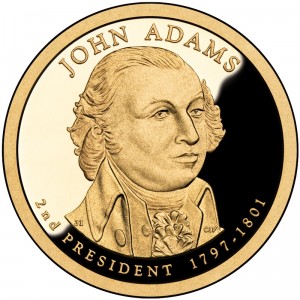
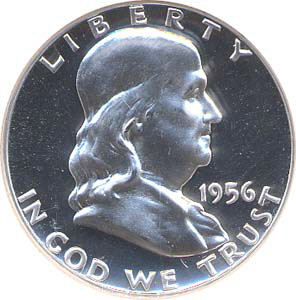



 Although there is no written history on what happened that evening, there had to have been lobbying by supporters of independence because on July 2, South Carolina voted yes followed by a turnaround by the Pennsylvania delegation that also voted yes. New York with no authority from their government continued to abstain. With the Delaware delegation deadlocked, this set up the historical ride of
Although there is no written history on what happened that evening, there had to have been lobbying by supporters of independence because on July 2, South Carolina voted yes followed by a turnaround by the Pennsylvania delegation that also voted yes. New York with no authority from their government continued to abstain. With the Delaware delegation deadlocked, this set up the historical ride of 








